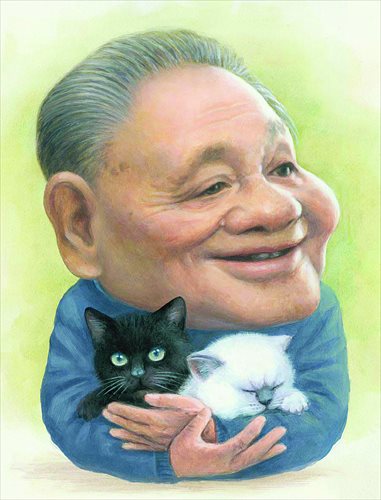

Caricature of Deng Xiaoping by Zhu Zizun with Deng holding one white cat and one black cat in his arms, a tribute to his famous remark: "It doesn't matter if a cat is black or white, so long as it can catch mice," referring to China's choice of economic systems. Photo: Courtesy of Zhu Zizun
Political cartoons are having a hard time in China, a far cry from the "Golden Age" of the 1980s. Behind the decline lie weakening print media and a distaste for satire and confrontation deeply ingrained in Chinese traditional values. But some cartoonists believe that social media could help revive China's flagging political cartoon tradition.
A baby sheep aims a hard kick at an ugly man, dressed like an ancient Chinese charlatan and holding a banner that says "Nine out of 10 people born in the year of the sheep have unlucky lives."
The cartoon, criticizing a superstition that is likely to cause a drop in newborn babies in the coming Year of the Sheep in China, was the front-page cartoon on the latest issue of Satire and Humor, a weekly Chinese newspaper that publishes political cartoons along with social and political commentary.
When the world was talking about the terrorist attack on French magazine Charlie Hebdo and lamenting the terrible price for free speech, Chinese cartoon publications seemed to be keeping a distance from the discussion. Many of them are quietly sinking into oblivion.
Once China's most popular cartoon newspaper, Satire and Humor, for example, is now hard to find at the country's newsstands, so it's no surprise that its circulation has shrunk over 90 percent, from 1.32 million copies during its peak in the 1980s to around 80,000 copies today, according to Xiao Chengsen, the publication's managing editor-in-chief. "We feel embarrassed when compared with our predecessors," Xiao, aged 50, told the Global Times.
The decline of China's only remaining cartoon newspaper is a reminder of the bitter situation facing China's political cartoons today, complicated by factors including the decline of print media, a distaste for satire and confrontation deeply ingrained in Chinese traditional values.
A glorious history
In January 1979, cartoonist Ying Tao founded Satire and Humor as a supplement of People's Daily, the official newspaper of the Communist Party of China (CPC), with the approval of Hu Yaobang, then head of the Publicity Department of the CPC Central Committee. The Gang of Four, the political clique that was believed to be behind the Cultural Revolution (1966-76) and other backward social phenomenon in the society, were its main targets.
The paper's birth marked the beginning of a golden age of China's political cartoons. The Cultural Revolution had just ended, and artists, both professional and amateur, threw off the ideological shackles of the movement and stepped into the new age with hopes for freer speech and more space for art.
In an interview with the Associated Press in 1986, Ying said the paper received over 100 cartoons a day from enthusiastic amateurs who wanted to have their satirical or humorous works published.
Hungry after 10 years of drab cultural and political life during the Cultural Revolution, readers vented their pent-up emotions through reading the paper's pungent and witty criticism of the Gang of Four and other current events. According to a memoir by Ying, in the 1980s, people would line up in front of the post offices on the morning of each publication day, waiting to buy the paper. At newsstands, copies were often sold out within hours. Circulation soared.
It was also a golden age for editorial cartoons in general. Apart from Satire and Humor, The World of Cartoons, a weekly newspaper, was launched in Shanghai in 1985 and Cartoon Monthly, the first cartoon magazine in China, was launched in Hebei Province in the same year.
Xiao recalled that in the 1980s, almost every local-level Party newspaper had a cartoon column. A worker at a factory in Shenyang, Liaoning Province at that time, Xiao started his painting career by sending his amateur works to local newspapers.
His first work was published in 1988 on Yingkou Daily, Party newspaper of Yingkou, a port city in Liaoning Province. "It depicted a Buddhist temple which was turned into a kasaya shop, criticizing the nationwide business fever at that time," Xiao said.
No appetite for satire
But all that is a distant memory. The past decade saw Shanghai's Cartoon World fold and Cartoon Monthly switch to print comic strips in a market-driven change. In the meantime, the number of cartoon columns in newspapers dwindled to almost nothing. Xiao estimates that only 20 newspapers in China still publish editorial cartoons on a regular basis today.
The critical nature of political cartoons is considered a major reason they are not welcomed by the Chinese officials.
Copyright ©1999-2018
Chinanews.com. All rights reserved.
Reproduction in whole or in part without permission is prohibited.